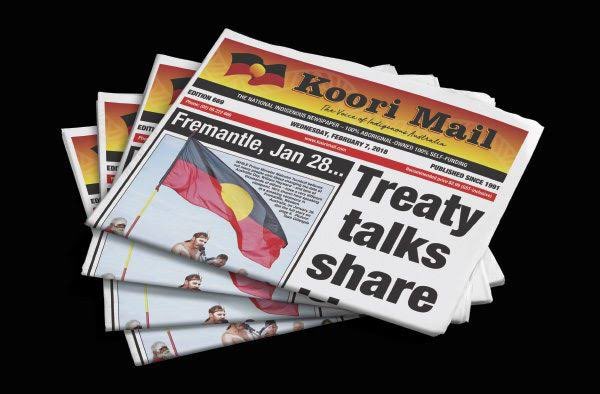
My eyes were opened to Black Media in this country in the early 1990s when I sighted a copy of the newly launched Koori Mail newspaper. The masthead got me. Our colours. A war cry. An apparatus about us, but for us, and obviously from us 

Over the past decade important new Black Media entrants have infiltrated Australia’s media ecology & contributed significantly to improving representation within the sector. This account is one of them. But their advocacy is far from new
One hundred and seventy-odd years before social media and new digital news media began to shift standard of representation of Blackfullas, the Flinders Island Chronicle launched. It was the first know news outlet operated by and for Aboriginal people
It was handwritten in English and produced by three Aboriginal writers/editors: Walter George Arthur; Walter Juba Martin; Thomas Brune. They provided reportage of daily life for the Aboriginal people being detained on the isolated Flinders Island settlement
This detention centre - called Wybalenna - was presided over by George Augustus Robinson, and the 2 Walters and Thomas were serving as his ‘clerks’. Truganini & Mannalargenna was there too. Anyway, in 1834/1835 Wybalenna shut down & in 1838/39 GA Robinson hopped the strait to …
the new mainland settlement that would become Victoria where he became the ‘Chief Protector of Aborigines’. He brought a mob from Wybalenna across with him too, including at least one of those Flinders Island Chronicle journalists
Thus the first known Black working journalist in Melbourne was from Tasmania - there you go. The next really cool & very significant chapter in Black Media then begins in the mid 1920s with the Australian Aboriginal Progressive Association and a Worimi fella Fred Maynard
That’s when we start to see some serious organising that was what we may now recognise as the start of the self determination movement in the newly established Commonwealth. A big influence on Maynard & the AAPA was the work of Marcus Garvey.
Maynard’s grandson John Maynard has written about it here aiatsis.gov.au/sites/default/…
From the AAPA in the 1920s, emerged the Aborigines Progressive Association (APA) in the 1930s. Black political luminaries like Bill Ferguson, Pearl Gibbs, William Cooper, and Jack Patton and others
In 1938 the APA produced a newspaper edited by Patton called Abo Call: the voice of the Aborigines. It reported on matters of interest to Aboriginal communities, including living conditions on the missions that a great many Aboriginal families had been forcibly detained on
During the Assimilation era of the 1940s - 1960s Black writers and journalists continued to contribute to periodicals - sometimes these outlets were produced by Blackfullas, sometimes they were operated by whitefullas but had Blackfullas producing them, & other variations
There was the Westralian Aborigine produced by the Coolbaroo League for example noongarculture.org.au/coolbaroo-leag…. A 1996 Anthology by Michael Rose titled For The Record lists some more.
In 1979, an academic paper by Brownlee Kirkpatrick & Marcia Langton titled A Listing of Aboriginal Periodicals provided an audit of periodicals and annual reports produced across the period 1930s -1960s that provided reliable reportage & other information useful to community 

Here’s a picture of Roy Orbison playing a yidaki in the 1960s that in no way relates to this thread but is very cool. I grew up listening to Roy Orbison. Dad swears Roy visited him in a dream one night in 1992. 

Back to the thread: some of the apparatus across that period that included reportage by Blackfullas are outlets like Smoke Signals from Vic’s Aborigines Advancement League and FCAATSI annual reports
By the mid to late 1960s we see Blak Media proliferate. One of the first was The Koorier produced her in Vic by today’s Blak Superhero Bruce McGuinness which advocated Aboriginal self-determination in the same manner the Abo Call did back in 1938 

Anyway, I’ve written about all this for the project I’m working on at the moment about Truth-Telling in Victoria. If you’re interested in the history of Black Media or Indigenous news media to be more specific keep an eye out for it next month.
I’ll tie this thread off with this tho: until very recently, there existed two prevailing views from mainstream/white newsrooms about Blackfulla journalists and Aboriginal affairs stories.
The first is plain false but remained all-too-common among white editors and journalists for way too long: the belief that Blak journalists are incapable of reporting on Indigenous affairs
Celebrated white journalists have shared this chestnut of racism with other white journalists in the past five years. I know because I was within earshot.
The second fallacy is that general audiences are not interested in Aboriginal affairs. Over the past 5-10 years this has also proven increasingly false. Look at the number of bodies in the street in June/July 2020 for #BlackLivesMatter rallies in this country; same with Jan 26
Audience appetite for anything related to Blak/Black/Blackfulla News has increased well beyond the interest of minority groups. As Gary Foley said from the back of a flatbed truck recently:
“What has changed, standing out here and looking at all of you mob, is the large numbers of ordinary Australians that are out here with us.”
End of thread. Nighty night. 🎶 A candy-colored clown they call the sandman
Tiptoes to my room every night
Just to sprinkle stardust and to whisper
Go to sleep, everything is alright…🎶
Tiptoes to my room every night
Just to sprinkle stardust and to whisper
Go to sleep, everything is alright…🎶
If you want to follow me at @LatimoreJack I’ll post the article there when it is published next month. There’s another whole 40-50 years that I write about from The Koorier to the present. But it is an article for a newspaper. Maybe I should write a book or something 🤔
Here’s a short thing I did a few years ago for this publication indigenousx.com.au/jack-latimore-…
• • •
Missing some Tweet in this thread? You can try to
force a refresh





